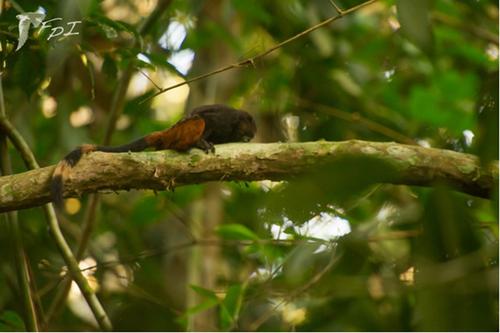当前位置:
X-MOL 学术
›
Am. J. Primatol.
›
论文详情
Our official English website, www.x-mol.net, welcomes your
feedback! (Note: you will need to create a separate account there.)
On the trail of primate scent signals: A field analysis of callitrichid scent‐gland secretions by portable gas chromatography‐mass spectrometry
American Journal of Primatology ( IF 2.0 ) Pub Date : 2021-02-03 , DOI: 10.1002/ajp.23236 Alice C Poirier 1, 2 , John S Waterhouse 2 , Mrinalini Watsa 3, 4 , Gideon A Erkenswick 4, 5, 6 , Laís A A Moreira 1 , Jia Tang 1 , Jacob C Dunn 2, 7, 8 , Amanda D Melin 1, 9 , Andrew C Smith 2
American Journal of Primatology ( IF 2.0 ) Pub Date : 2021-02-03 , DOI: 10.1002/ajp.23236 Alice C Poirier 1, 2 , John S Waterhouse 2 , Mrinalini Watsa 3, 4 , Gideon A Erkenswick 4, 5, 6 , Laís A A Moreira 1 , Jia Tang 1 , Jacob C Dunn 2, 7, 8 , Amanda D Melin 1, 9 , Andrew C Smith 2
Affiliation

|
Chemosignals are mediators of social interactions in mammals, providing con‐ and hetero‐specifics with information on fixed (e.g., species, sex, group, and individual identity) and variable (e.g., social, reproductive, and health status) features of the signaler. Yet, methodological difficulties of recording and quantifying odor signals, especially in field conditions, have hampered studies of natural systems. We present the first use of the Torion® portable gas chromatography‐mass spectrometry (GC‐MS) instrument for in situ chemical analysis of primate scents. We collected and analyzed swab samples from the scent glands and skin from 13 groups (57 individuals) of two sympatric species of wild emperor tamarins, Saguinus imperator, and Weddell's saddleback tamarins, Leontocebus weddelli (Callitrichidae). In total, 11 compounds of interest (i.e., probably derived from the animals) could be detected in the samples, with 31 of 215 samples containing at least one compound of interest. The composition of these 31 samples varied systematically with species, group, sex, and breeding status. Moreover, we tentatively identified seven of the compounds of interest as methyl hexanoate, benzaldehyde, ethyl hexanoate, acetophenone, a branched C15 alkane, 4‐methoxybenzaldehyde, and hexadecan‐1‐ol. As the field of primate semiochemistry continues to grow, we believe that portable GC‐MS instruments have the potential to help make progress in the study of primate chemosignaling in field conditions, despite limitations that we encountered. We further provide recommendations for future use of the Torion® portable GC‐MS for in situ analyses.
中文翻译:

灵长类动物气味信号的踪迹:便携式气相色谱-质谱法对callitrichid气味腺分泌物的现场分析
化学信号是哺乳动物社会互动的中介,为同种和异种特异性提供关于信号者固定(例如,物种、性别、群体和个体身份)和可变(例如,社会、生殖和健康状况)特征的信息. 然而,记录和量化气味信号的方法困难,尤其是在野外条件下,阻碍了对自然系统的研究。我们首次使用 Torion® 便携式气相色谱-质谱 (GC-MS) 仪器对灵长类动物气味进行原位化学分析。我们收集并分析了来自 13 组(57 只)野生帝王狨猴Saguinus imperator和威德尔马鞍狨猴Leontocebus weddelli的气味腺和皮肤的拭子样本(Callitrichidae)。总共可以在样品中检测到 11 种感兴趣的化合物(即可能来自动物),其中 215 个样品中的 31 个至少含有一种感兴趣的化合物。这 31 个样本的组成因物种、群体、性别和繁殖状态而有系统地变化。此外,我们初步确定了七种感兴趣的化合物,包括己酸甲酯、苯甲醛、己酸乙酯、苯乙酮、支链 C15 烷烃、4-甲氧基苯甲醛和 1-十六烷醇。随着灵长类信息化学领域的不断发展,我们相信便携式 GC-MS 仪器有潜力帮助在野外条件下灵长类化学信号的研究取得进展,尽管我们遇到了一些限制。我们进一步为将来使用 Torion® 便携式 GC-MS 进行原位分析提供了建议。
更新日期:2021-02-23
中文翻译:

灵长类动物气味信号的踪迹:便携式气相色谱-质谱法对callitrichid气味腺分泌物的现场分析
化学信号是哺乳动物社会互动的中介,为同种和异种特异性提供关于信号者固定(例如,物种、性别、群体和个体身份)和可变(例如,社会、生殖和健康状况)特征的信息. 然而,记录和量化气味信号的方法困难,尤其是在野外条件下,阻碍了对自然系统的研究。我们首次使用 Torion® 便携式气相色谱-质谱 (GC-MS) 仪器对灵长类动物气味进行原位化学分析。我们收集并分析了来自 13 组(57 只)野生帝王狨猴Saguinus imperator和威德尔马鞍狨猴Leontocebus weddelli的气味腺和皮肤的拭子样本(Callitrichidae)。总共可以在样品中检测到 11 种感兴趣的化合物(即可能来自动物),其中 215 个样品中的 31 个至少含有一种感兴趣的化合物。这 31 个样本的组成因物种、群体、性别和繁殖状态而有系统地变化。此外,我们初步确定了七种感兴趣的化合物,包括己酸甲酯、苯甲醛、己酸乙酯、苯乙酮、支链 C15 烷烃、4-甲氧基苯甲醛和 1-十六烷醇。随着灵长类信息化学领域的不断发展,我们相信便携式 GC-MS 仪器有潜力帮助在野外条件下灵长类化学信号的研究取得进展,尽管我们遇到了一些限制。我们进一步为将来使用 Torion® 便携式 GC-MS 进行原位分析提供了建议。











































 京公网安备 11010802027423号
京公网安备 11010802027423号